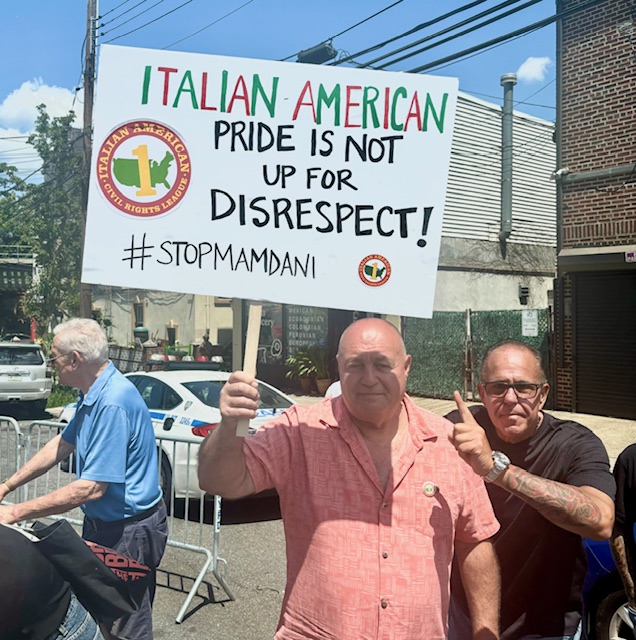Tensions escalated on July 21, 2023, as dueling protests took place outside the Astoria office of Assemblymember and mayoral candidate Zohran Mamdani. The events highlighted stark political and cultural divides in New York City’s contentious election landscape. Demonstrators, representing various organizations, gathered to voice their strong opposition to Mamdani’s perceived disrespect towards Italian-American heritage.
On one side of 31st Street near Broadway, members of the Italian American Civil Rights League (IACRL), along with supporters from New Yorkers First and the American Brotherhood Motorcycle Club, rallied under American, Italian, and Israeli flags. The group kicked off their demonstration with the National Anthem and chants of “USA! USA!” They displayed signs proclaiming “Italian American pride is not up for disrespect, #StopMamdani.” Organizers like Frank J. Spotorno emphasized their commitment to preserving their heritage, stating, “We will not be erased. And we are the manifestation of that today.”
The protests were ignited by a resurfaced image of Mamdani making a gesture towards a statue of Christopher Columbus, which critics deemed offensive to the Italian-American community. Participants criticized Mamdani’s association with the Democratic Socialists of America (DSA), alleging that he was undermining traditional values.
Gerard Marrone, vice president of the IACRL, articulated the group’s sentiments: “This is not about a statue. This is about who we are. Zohran Mamdani gave the finger to Columbus. That’s an affront to all Italian-American patriots who built this city.” Some protesters went further, accusing Mamdani of aligning with extremist groups and labeling him a Marxist.
Across the street, Mamdani’s supporters, many clad in shirts reading “Zohran Mamdani for Mayor,” countered with chants of “Socialism” and “No Pride in Genocide!” The atmosphere grew heated, as both sides exchanged insults across police barricades.
Mamdani’s absence from the protests further fueled discontent. He was reportedly in Uganda for two weeks, a fact that drew sharp criticism from demonstrators. One protester shouted, “Why are you going to Uganda in the middle of campaign season?” This absence prompted many to question his commitment to the constituents he aims to serve.
Adding a theatrical element to the protests, conservative artist Scott LoBaido showcased a provocative mobile billboard featuring Mamdani and Mayor Eric Adams in a controversial portrayal. The artwork, titled “Pick Me, Pick Me Again,” depicted a fiery cityscape, and resonated with the assembled crowd, drawing applause.
As the protests unfolded, tensions escalated, with the presence of the NYPD ensuring that confrontations did not turn violent. Mamdani’s backers defended his policies, including rent freezes aimed at helping low-income residents, while others voiced their disapproval of his political alignment.
The protests reflected a broader discontent within the city, where many expressed their desire for a mayor who would prioritize safety and community values. The only unified sentiment among the protesters was the rallying cry for “ABZ” — “Anybody but Zohran” — indicating a fractured political landscape as the 2025 mayoral race approaches.
As the demonstrations concluded, one protester posed a poignant question to the press: “Is this the New York we want—where radicals mock our history, insult our heritage, and run from accountability?” The incident serves as a reminder of the complex intersections of politics, identity, and community in a rapidly changing urban environment.
